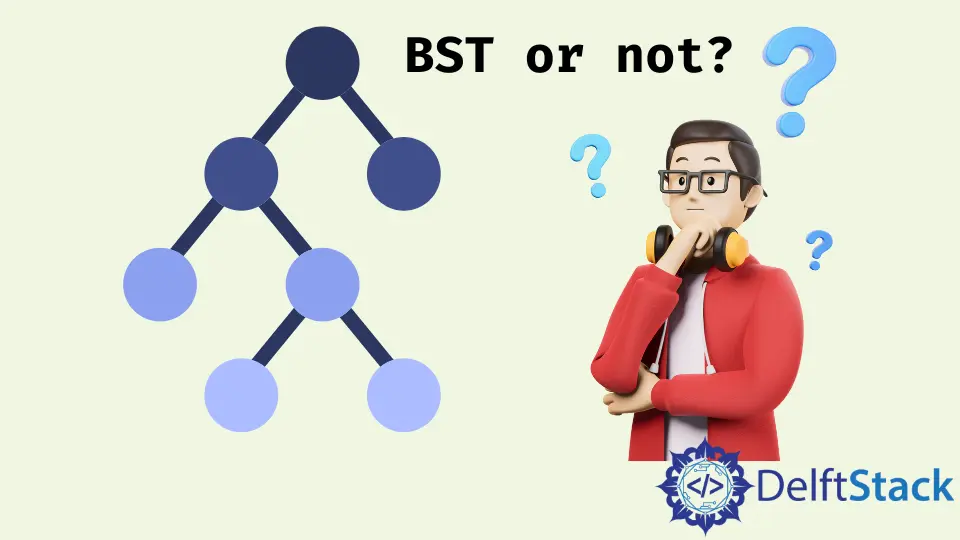二叉搜尋樹檢查

二叉樹是一種非線性資料結構。它被稱為二叉樹,因為每個節點最多有兩個子節點。這些子節點被稱為左子和右子。一個二叉樹要想成為 BST,必須滿足以下屬性。
- 左側子樹的所有節點都比根節點小。
- 右側子樹中的所有節點都比根節點大。
- 左子樹和右子樹也必須是二元搜尋樹。
二叉樹是否為二叉搜尋樹的檢驗演算法
演算法 1
在這種方法中,我們通過將每個節點視為其子樹的根,來檢查左子樹是否包含任何大於根值的元素,以及右子樹是否包含小於根值的元素。為了找到最大和最小元素,我們必須使用兩個獨立的函式 getMin() 和 getMax()。
getMin()
-
初始化
temp為root。 -
當
temp有一個left時,執行以下操作。- 設定
temp為temp->left,即向左移動找到最小的元素。
- 設定
-
返回
temp->val作為該子樹的最小值。
getMax()
-
初始化
temp為root。 -
當
temp有一個right時,執行以下操作。- 設定
temp為temp->right,即向右移動找到最大的元素。
- 設定
-
返回
temp->val作為該子樹的最大值。
isBST(root)
-
如果
root是NULL,返回true。 -
通過呼叫 getMax(root->left)在左邊子樹中找到最大元素
maxm。 -
通過呼叫 getMin(root->right)在右側子樹中查詢最小元素
minm。 -
如果根元素小於
maxm或大於minm,返回 false。 -
通過呼叫
isBST(root->left)和isBST(root->right)遞迴檢查所有節點。如果兩個遞迴呼叫都返回 true,那麼這棵樹就是 BST,返回 true,否則返回 false。
上面的演算法告訴我們一棵樹是否是 BST,但速度極慢。函式 getMin() 和 getMax() 在最壞情況下的時間複雜度為 O(n),它們是為 n 節點呼叫的,使得總的時間複雜度為 O(n2)。
演算法 2
該演算法在前一種演算法的基礎上進行改進,不做重複計算。前一種方法對每個節點都呼叫 getMin() 和 getMax()。這個方法在上面的方法上做了改進,在我們遍歷節點的時候,一直跟蹤最小值和最大允許值。
isBST(root)
-
初始化兩個變數
min為INT_MIN,max為INT_MAX。 -
呼叫
isBST(root,min,max)。
isBST(root, min, max)
-
如果
root是NULL,返回true。 -
如果
min>root->data,則違反 BST 屬性,返回 false。 -
如果
max<root->data,則違反 BST 屬性,返回 false。 -
通過呼叫
isBST(root->left, min, root->data-1)遞迴檢查左子樹(傳遞min和root->data - 1作為引數改變左子樹中 BST 的有效範圍),通過呼叫isBST(root->right, root->data+1, max)遞迴檢查右子樹(傳遞root->data + 1和max作為引數改變右子樹中 BST 的有效範圍)。 -
如果兩個遞迴呼叫都返回
true,則樹為 BST,返回true。
此演算法的時間複雜度為 O(n),比前一種方法有很大的改進。
演算法 3
這個演算法避免了上面演算法中使用 INT_MIN 和 INT_MAX,用兩個指標 l 和 r 代替。
isBST(root)
-
初始化兩個節點
l和r為NULL。 -
呼叫
isBST(root, l, r)。(過載函式呼叫)
isBST(root, l, r)
-
如果
root是NULL,返回true。 -
如果
l不是NULL並且l->data>=root->data,則違反 BST 屬性,返回 false。 -
如果
r不是NULL並且r->data<=root->data,那麼 BST 屬性被違反,返回 false。 -
通過呼叫
isBST(root->left, left, root)(將 root 作為第三個引數傳遞,改變子樹的最小值限制)和呼叫isBST(root->right, root, right)(將 root 作為第二個引數傳遞,改變子樹的最大值限制)來遞迴檢查左邊的子樹。 -
如果兩個遞迴呼叫都返回
true,則該樹為 BST,返回true。
演算法 4:
二叉搜尋樹的 inorder 遍歷按排序順序返回元素。我們可以利用這個特性來檢查一棵二叉樹是否為 BST。如果無序遍歷中的所有元素都不是按升序排列,那麼給定的樹就不是二叉搜尋樹。
isBST(root)
-
將變數
prev初始化為INT_MIN。prev用於檢查當前節點是否大於prev,從而按照排序順序進行。 -
呼叫
isBST(root, prev)。(過載函式 Call)。
isBST(root,prev)
-
如果
root是NULL,返回true。 -
通過
isBST(root->left, prev)遞迴檢查左子樹。如果返回false,則返回 false。 -
如果
root->data<=prev,違反了升序,返回 false。 -
將
prev->data更新為root->data。 -
通過
isBST(root->right, prev)遞迴檢查右子樹。如果返回false,則返回 false。 -
否則,返回 true。
檢查二叉樹是否為二叉搜尋樹的演算法實現方法
演算法 1
#include <iostream>
using namespace std;
class Node {
public:
int data;
Node *left, *right;
Node(int x) {
this->data = x;
this->left = this->right = NULL;
}
};
int getMin(Node* root) {
while (root->left) {
root = root->left;
}
return root->data;
}
int getMax(Node* root) {
while (root->right) {
root = root->right;
}
return root->data;
}
bool isBST(Node* root) {
if (root == NULL) return true;
if (root->left != NULL && getMax(root->left) > root->data) return false;
if (root->right != NULL && getMin(root->right) < root->data) return false;
if (!isBST(root->left) || !isBST(root->right)) return false;
return true;
}
int main() {
Node* root = new Node(6);
root->left = new Node(3);
root->right = new Node(9);
root->left->left = new Node(1);
root->left->right = new Node(5);
root->right->left = new Node(7);
root->right->right = new Node(11);
if (isBST(root)) {
cout << "This binary tree is a BST." << endl;
} else {
cout << "This binary tree is not a BST." << endl;
}
return 0;
}
演算法 2
#include <iostream>
using namespace std;
class Node {
public:
int data;
Node *left, *right;
Node(int x) {
this->data = x;
this->left = this->right = NULL;
}
};
bool isBST(Node* root, int min, int max) {
if (root == NULL) return 1;
if (root->data < min || root->data > max) return 0;
return isBST(root->left, min, root->data - 1) &&
isBST(root->right, root->data + 1, max);
}
bool isBST(Node* root) { return isBST(root, INT_MIN, INT_MAX); }
int main() {
Node* root = new Node(6);
root->left = new Node(3);
root->right = new Node(9);
root->left->left = new Node(1);
root->left->right = new Node(5);
root->right->left = new Node(7);
root->right->right = new Node(11);
if (isBST(root)) {
cout << "This binary tree is a BST." << endl;
} else {
cout << "This binary tree is not a BST." << endl;
}
return 0;
}
演算法 3
#include <iostream>
using namespace std;
class Node {
public:
int data;
Node *left, *right;
Node(int x) {
this->data = x;
this->left = this->right = NULL;
}
};
bool isBST(Node* root, Node* l, Node* r) {
if (root == NULL) return true;
if (l != NULL and root->data <= l->data) return false;
if (r != NULL and root->data >= r->data) return false;
return isBST(root->left, l, root) && isBST(root->right, root, r);
}
bool isBST(Node* root) {
Node* l = NULL;
Node* r = NULL;
return isBST(root, l, r);
}
int main() {
Node* root = new Node(6);
root->left = new Node(3);
root->right = new Node(9);
root->left->left = new Node(1);
root->left->right = new Node(5);
root->right->left = new Node(7);
root->right->right = new Node(11);
if (isBST(root)) {
cout << "This binary tree is a BST." << endl;
} else {
cout << "This binary tree is not a BST." << endl;
}
return 0;
}
演算法 4
#include <iostream>
using namespace std;
class Node {
public:
int data;
Node *left, *right;
Node(int x) {
this->data = x;
this->left = this->right = NULL;
}
};
bool isBST(Node* root, int& prev) {
if (!root) return true;
if (!isBST(root->left, prev)) return false;
if (root->data <= prev) return false;
prev = root->data;
return isBST(root->right, prev);
}
bool isBST(Node* root) {
int prev = INT_MIN;
return isBST(root, prev);
}
int main() {
Node* root = new Node(6);
root->left = new Node(3);
root->right = new Node(9);
root->left->left = new Node(1);
root->left->right = new Node(5);
root->right->left = new Node(7);
root->right->right = new Node(11);
if (isBST(root)) {
cout << "This binary tree is a BST." << endl;
} else {
cout << "This binary tree is not a BST." << endl;
}
return 0;
}
複雜度分析
時間複雜度
- 平均情況
為了檢查給定的二叉樹是否是 BST,我們必須遍歷所有 n 節點,因為一個不符合屬性的節點將導致該樹不是 BST。因此,時間複雜度是 [Big Theta]:O(n)。
- 最佳情況
最佳情況下的時間複雜度為 O(n)。它與平均情況下的時間複雜度相同。
- 最壞情況
最壞情況下的時間複雜度為 O(n)。它與最佳情況下的時間複雜度相同。
空間複雜度
由於遞迴呼叫所需的額外空間,該演算法的空間複雜度為 O(n)。
Harshit Jindal has done his Bachelors in Computer Science Engineering(2021) from DTU. He has always been a problem solver and now turned that into his profession. Currently working at M365 Cloud Security team(Torus) on Cloud Security Services and Datacenter Buildout Automation.
LinkedIn